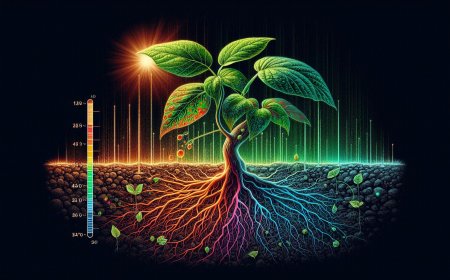Thigmotropism: How Plants Sense and Respond to Touch
Discover the fascinating concept of thigmotropism, where plants like vines and tendrils respond to touch stimuli to find support and thrive. Explore how plants sense and react to physical contact.

In the captivating world of plant biology, one of the most intriguing phenomena is thigmotropism. Unlike animals, plants can't physically move to escape danger or seek out food, but they have evolved remarkable ways to interact with their environment. Thigmotropism is one such adaptation that allows plants to sense and respond to touch, enabling them to find support, avoid obstacles, and adapt to their surroundings. But what exactly is thigmotropism, and how does it work? Let’s explore the fascinating ways plants use this unique sense to thrive.
Understanding Thigmotropism
Thigmotropism comes from the Greek word thigma, meaning “touch,” and trope, meaning “to turn.” Essentially, it refers to a plant’s ability to change its growth pattern in response to physical contact. In simple terms, when a plant senses a touch stimulus, it modifies its direction or rate of growth accordingly. This response can be seen in many plants, but it is particularly evident in climbing plants, vines, and tendrils, which rely on external supports to grow upward.
How Thigmotropism Works
Thigmotropism is driven by intricate biological processes involving cells and hormones. When a plant detects touch, its cells release growth hormones called auxins. These hormones then redistribute to encourage cells on one side of the plant to elongate while restricting growth on the other side, causing the plant to curve toward or away from the stimulus.
This remarkable touch response relies on specialized cells in the plant’s epidermis (outer layer) that can sense physical changes in their environment. When these cells detect pressure, they send signals to other cells, which adjust growth patterns to form the characteristic curling, twisting, or clinging movement that allows the plant to seek out support structures.
Types of Thigmotropic Responses
Thigmotropism is commonly classified into two main types based on the direction of growth:
- Positive Thigmotropism: This is when plants grow toward the source of touch. For instance, tendrils and climbing vines like pea plants, ivy, and morning glories exhibit positive thigmotropism. As they touch a structure, they coil around it, securing support to grow higher and access more sunlight.
- Negative Thigmotropism: In contrast, some plants grow away from a touch stimulus. This is often seen in the roots of certain plants, which change direction to avoid obstacles. By avoiding growth in the direction of rocks or compacted soil, roots maximize their chances of finding better soil conditions and nutrients.
Fascinating Examples of Thigmotropism in Nature
- Tendrils and Climbers: Plants like cucumber, grapes, and passionflowers exhibit thigmotropism to climb structures. As soon as their tendrils come in contact with a nearby object, they start to wrap around it, providing a steady anchor for the plant to grow vertically.
- The Sensitive Plant (Mimosa pudica): The sensitive plant takes thigmotropism to an extreme. When touched, its leaves fold inward within seconds. This rapid movement, known as thigmonasty, isn’t technically growth but a similar response to physical stimulus aimed at deterring herbivores and protecting the plant from harm.
- Venus Flytrap: The Venus flytrap is another fascinating example. While technically not a thigmotropic response (it’s thigmonastic), it uses touch-sensitive hairs to trap insects. When an insect touches these hairs twice in quick succession, the trap snaps shut, providing nutrients to the plant.
The Importance of Thigmotropism
Thigmotropism is an evolutionary advantage that allows plants to survive and thrive in diverse environments. By finding support or avoiding obstacles, plants can grow in crowded areas, reach sunlight, and maximize nutrient intake, which are critical to their survival. In the larger ecological context, thigmotropism contributes to the biodiversity and complexity of habitats, providing shelter and food sources for other organisms.
Applications of Thigmotropism in Agriculture and Horticulture
Understanding thigmotropism has led to innovative techniques in agriculture. By using support structures or trellises that enhance thigmotropic responses, farmers and gardeners can cultivate crops more efficiently. This is particularly useful for plants that grow better vertically, like tomatoes, cucumbers, and beans, which benefit from reduced ground space and increased airflow.
Conclusion
Thigmotropism reveals the surprising ways plants interact with their world, showing us that plants are more perceptive and responsive than we often assume. This natural phenomenon is a testament to the adaptability of life and reminds us that plants, though rooted in place, are far from passive. They’re constantly sensing, adapting, and responding to the touch of their surroundings.
What's Your Reaction?





























